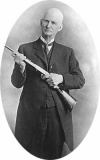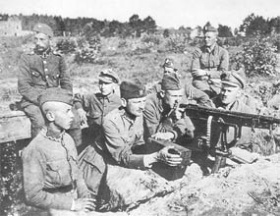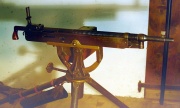M1895 Colt-Browning machine gun
Contents |
[edit] Operating mechanism
Filed for patent in 1892, the M1895's operating mechanism was one of Browning's early patents for automatic rifles[1][2]; he had previously been working on lever action rifles for Winchester such as the Winchester 1886. The M1895 uses a unique operating mechanism, which is quite similar to that of a lever action rifle. The earliest prototype developed by Browning in early 1889 was a .44 caliber black powder cartridge rifle, weighing under 12 pounds, which was capable of firing 16 shots in under one second. Operation was via a lever located under the barrel, which operated the action when swung downwards. The lever was actuated by the muzzle blast operating upon it.[3]
[edit] Development
An improved design based on Browning's prototype lever mechanism was offered to Colt by Browning in 1892. The lever was moved back, and power was supplied by a gas port about six inches (15 cm) back from the muzzle. To minimize heating during rapid fire, the gun uses a very heavy, finned barrel, bringing its weight up to 35 pounds; the standard tripod mount with seat for the gunner, added another 56 pounds. Despite the heavy barrel, the closed bolt mechanism would cook off shots if a round was left chambered in a hot barrel. This required that the gun be unloaded immediately after an extended burst of firing.[3] During testing of the gun, it was found to be capable of firing extended bursts of over 1000 rounds before the barrel overheated and bullets began to tumble out of control; upon stopping, the red hot barrel cooked off four or five additional shots before cooling down.[4]
The gun was originally chambered in 6 mm Lee Navy and later, after the adoption of the Krag-Jorgensen rifle, in .30-40 Krag, 7x57mm Mauser caliber (the same cartridge used in the Spanish Model 1893 Mauser), and .30-06 Springfield in 1914. The 1914 version also included a lower tripod for firing prone; this is likely what led to the gun's nickname of "potato digger", as the operating lever would dig into the ground if it were fired from too low a position.[5]
The M1895 was made for export as well; the Russians ordered several thousand M1895 machine guns in 1914 for use in World War I, and it saw service in England, France, and various countries in South America.[6]
[edit] Use
The M1895 was the first machine gun adopted by the United States military, and it saw service with the Army, Navy, and Marines, and was adapted to use in many roles. It was mounted in tripods, horse drawn carriages, boats, aircraft, and even armored cars. The Navy was the first to begin testing, as early as 1893, with a version chambered in the Navy's 6mm cartridge.[7][8]
[edit] Early conflicts
The M1895 saw extensive service with the United States during the Spanish American War, including the 1898 invasion of Guantanamo Bay by U.S. Marines. It was also utilized by American forces during the Philippine–American War, and the Boxer Rebellion, where it proved to be accurate and reliable.[9] The M1895 also saw use throughout the protracted Mexican Revolution, where it was one of few machine guns to see use in that conflict.[10][11]
Further south, the M1895 was also used by the Uruguayan Army against rebels during a late flare-up of the Uruguayan Civil War in 1904.
[edit] World War I
While the United States used the M1895 for training, it was considered obsolete by the point the United States entered the war, and saw no service. Colt ceased production of the M1895 and variants in 1917, though a version made by Marlin Rockwell (currently Marlin Firearms) for tank and aircraft use, called the "Marlin Gun", continued through the end of World War I. The Marlin version replaced the swinging arm with a reciprocating piston, leaving the M1895 as the only production arm to use the unique lever operation.[6]
[edit] External links
[edit] References
- ↑ U.S. Patent 544,657
- ↑ Wilson, Mike. John Browning's Patent Numbers
- ↑ 3.0 3.1 Julian S. Hatcher (1962). Hatcher's Notebook. Stackpole Books. pp. 79–81. ISBN 0811707954.
- ↑ United States War Dept (1904). Annual Reports of the War Department. Govt. Print. Office. pp. 83–92.
- ↑ Roger Pauly (2004). Firearms: The Life Story of a Technology. Greenwood Publishing Group. ISBN 9780313327964.
- ↑ 6.0 6.1 United States Army. Ordnance Dept, Herbert Treadwell Wade (1919). Handbook of Ordnance Data. p. 307.
- ↑ Browning Machine Guns
- ↑ United States Navy Dept. (1893). Annual Reports of the Navy Department: Report of the Secretary of the Navy. Published by United States Government Printing Office. p. 235.
- ↑ Joseph H. Alexander, Don Horan, Norman C. Stahl (1999). The Battle History of the U.S. Marines: A Fellowship of Valor. HarperCollins. p. 26. ISBN 9780060931094.
- ↑ Philip S. Jowett, A. M. De Quesada, Stephen Walsh (2006). The Mexican Revolution 1910-20. Osprey Publishing. ISBN 9781841769899.
- ↑ THE WEAPONS COLLECTION REME MUSEUM of TECHNOLOGY
| This article is part of a series on the works of John Moses Browning | ||
|---|---|---|
| Semi-automatic pistols | FN M1900 · Colt M1900 · Colt M1902 · FN Model 1903 · M1903 Pocket Hammer · M1903 Pocket Hammerless · M1908 Vest Pocket · FN Model 1910 · M1911 · Colt Woodsman · Baby Browning · Hi-Power |  |
| Rifles | Winchester Model 1885 · Winchester Model 1886 · Winchester 1892 · Winchester Model 1894 · Winchester Model 1895 · Remington Model 8 · Remington Model 24 · FN Trombone | |
| Shotguns | Winchester Model 1887 · Winchester Model 1897 · Browning Auto-5/Remington Model 11 · Remington Model 17 · Savage Model 520 · Browning Superposed · Ithaca 37 | |
| Machine guns | Colt-Browning M1895 · Browning M1917 · Browning Automatic Rifle · Browning M1919 · M2 Machine Gun | |
| Cartridges | .25 ACP · .32 ACP · .38 ACP · .380 ACP · .45 ACP · .50 BMG | |


